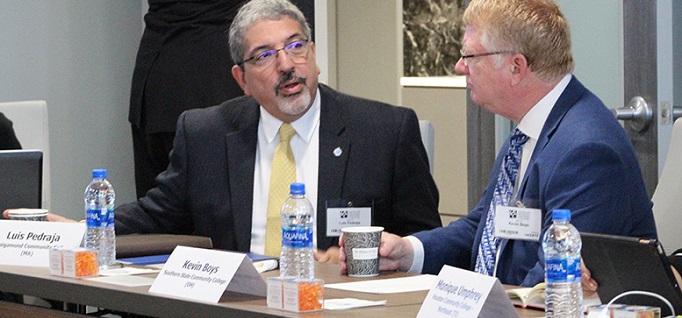Unfinished Business: ‘Our next frontier’
By Matthew Dembicki
May 1, 2019
Community college leaders work to tackle the equity gap.
Community colleges have excelled at providing students with access to higher education, and over the past several years have improved in helping their students succeed. But one area that remains a challenge for all higher education, including two-year colleges, is equity.
“We still are woefully inadequate in this area,” Walter Bumphus, president and CEO of the American Association of Community Colleges (AACC), said Wednesday during a convening of community college presidents at the AACC offices in Washington, D.C., to discuss issues of equity.
It’s now a priority that AACC is tackling through its Unfinished Business initiative, which aims to identify why achievement gaps persist and how to address them, from cultural sensitivity in the classroom, to ensuring there are jobs with family-sustaining wages waiting for students on the other end.
“It’s our next frontier,” Bumphus said.
The bigger picture
Since AACC held its first meeting on Unfinished Business in December, the idea has struck a chord with community college leaders and generated a buzz at the association’s annual convention this month. On Wednesday, AACC held its second meeting by inviting a dozen community college presidents to continue the discussion, which ranged from equity in dual enrollment and broadband connections, to working closer with K-12 partners and ensuring companies have good-paying jobs with advancement opportunities.
Among the topics discussed was reforming classrooms. Several presidents noted that student success doesn’t hinge on just developing pathways courses, but ensuring the quality of those programs. That requires faculty understanding their students better and making changes in the classroom. But having those discussions with faculty is not always easy, and they have led in some cases to clashes with faculty.
During a discussion about development education, the group noted that some schools are asking academic faculty to “deconstruct” workforce programs to determine what specific skills in math, reading and other subjects are needed for certain careers, rather than requiring students to take courses typically not needed for those jobs.
The leaders also discussed working more closely with K-12 on aligning curriculum so students are prepared for college-level work and don’t have to waste time and money taking developmental courses. One idea was to create a faculty institute to help community college instructors understand the need for better alignment. The faculty in turn would bring those conversations back to their K-12 districts.
AACC’s Bumphus noted the association holds regular co-meetings with AASA: The School Superintendents Association, where they explore promising practices by bringing in teams of college presidents and their local K-12 superintendents to share the successes and challenges of their partnerships.
At the end, jobs
A community may have a top-notch education and training system, but there must be jobs awaiting students, the group of presidents noted. Colleges could boost enrollment if they had more assurances that the education would lead to better-paying jobs, especially in fields desperate for skilled workers.
That requires frank discussions with employers. Several participants noted that some local companies approach them to create a program to develop a pipeline of workers, yet the companies are seeking to fill only one or two positions.
The college leaders said more accurate jobs data, especially from states, would help them better gauge current and future workforce needs, and the information would help students see the potential income in certain fields.
It’s also important to encourage students to consider their own future advancement and how to prepare for it. For example, a student who studies to be a welder may one day want to move in management or seek another opportunity. It’s important to show students those potential tracts as well as they study for their immediate job.
“Keep that aspiration on the front burner, not the back,” said Kevin Boys, president of Southern State Community College in Ohio.
There’s more to the story! Read the full article in CC Daily.



